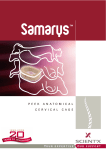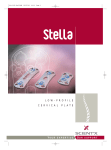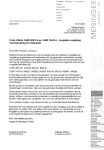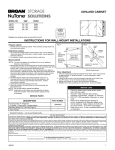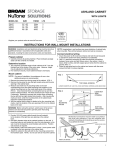Download PCB EVOLUTIONTM
Transcript
PCB EVOLUTION Corporate Headquarters: ALPHATEC SPINE, INC. 5818 El Camino Real Carlsbad, CA 92008 - USA TL +1 460 431 9286 www.alphatecspine.com 2-in-1 hybrid cervical plate-cage International Headquarters: SCIENT’X-ALPHATEC SPINE 22 avenue Jean Bart 78960 VOISINS-LE-BRETONNEUX - FRANCE TL +33 (0)1 39 30 69 30 - FX +33 (0)1 30 43 82 77 www.scientx.com - www.alphatecspine.com This product is not available for sale in the United States of America Non contractual pictures. Please read carefully the instructions for use bulletin. Devices may be subject to modification. Patented. PCB Evolution and the Scient'x-Alphatec Spine logo are registered trademarks of Alphatec Spine. © 2010 Alphatec Spine, Inc. All rights reserved. DOMKT503-en revision 1.0 / DMQ #11-057 / Approval date: June 2011 SURGICAL TECHNIQUE GUIDE TM FEATURES & BENEFITS 2-in-1 hybrid cervical plate-cage An evolution of the 2-in-1 titanium cervical plate-cage PCB Scient’x has designed a 2-in-1 system combining a titanium plate and a PEEK cage. The PCB Evolution allows disc height restoration by an anterior fixation and the radiotransparent cage permits a perfect visualization of cervical interbody fusion. Its unique stabilization plate prevents any possibility of posterior impaction or anterior ejection of the cage. The PCB Evolution plate-cage is mainly used for the surgical treatment of : • cervical hard and soft disc herniations • cervical degenerative pathologies on one or several levels • instabilities resulting in degenerative disc disease • corrections of spine statics disorders This implant can be implanted from C2 to C7. The PCB Evolution implant is available in different sizes allowing a perfect adaptation to the patient’s anatomical curvature. Its anatomically designed shape fits perfectly the intervertebral space while minimizing stress upon fixation screws. The PCB Evolution helps to restore the disc height and maintains correct spine static. This one piece-implant makes the placement easier and thereby reduces operative time. 2 in 1 system Operative time saving Anatomical shape Immediate stability • Integrated plate-cage for a secured system • Easy and fast insertion • Optimal fixation of the spinal segment Rapid and simplified identification of the available sizes thanks to color code • Pre-lordosed low-profile plate to minimize stress upon fixation screws • Cage height to ensure the restoration of the intervertebral space Stabilization plate to prevent the pull-out of the cage Multi-level implantation Optimized fusion Asymmetrical shape to combine several plate-cages in multi-segment arthrodesis Large graft surface to enhance bone fusion Hybrid implant • Titanium plate for a better mechanical resistance. Titanium TA6V ELI gives excellent biomechanical properties and allows scanner and MRI investigations. 2 • Radiotransparent PEEK cage to allow accurate fusion follow-up. PEEK is a biocompatible polymer which presents a modulus of elasticity close to that of cortical bone, therefore enhancing bone growth 3 SURGICAL TECHNIQUE 1 Surgical protocol/patient positioning a The procedure is performed under general anesthesia with endotracheal intubation. The patient is positioned in supine position on a standard table. The head is placed in a neutral position or rotated in the opposite direction to the approach. Rotation should be approximately 30° to limit stress on the sternocleido- mastoid muscle. The shoulders are lowered and fixed with self-adhesive strips in order to release the inferior cervical spine. b The skin incision targets the level of the lesion to be treated. It is marked on the skin after locating the lesion with an image intensifier. It may be horizontal, along a skin fold, extended to the opposite side of the median line in the case of bilateral approach, or beyond according to the number of levels to be treated. The platysma muscle is sectioned on the same plane as the skin, then two upper and lower detachments are created to avoid muscle tension. The aponeurotic planes are sectioned with the finger up to the anterior surface of the spine. Discectomy and preparation of the surgical site 2 The discectomy starts with the rectangular excision of the anterior part of the annulus fibrosus, using a scalpel. The disc material is resected using curettes and rongeurs. It may prove necessary to use microscope for resecting the posterior disc material. After full discectomy, resecting the posterior osteophytes and the caudal part of the uncus allows foramen release. Depending on the case, the common posterior vertebral ligament may or may not need to be resected. This essential surgical stage gives direct access to the anterior side of the medulla and nerve roots. c The muscles along the neck are separated and rugined to thoroughly release the operating area and allow proper retraction using an autostatic distractor. d Under scopic control the proper level is located, the Caspar distractor pins are positioned in the middle of the vertebral bodies over and under-lying the discal space to be treated and parallel to the endplates. 3 Preparing the vertebral endplates The endplate preparation is performed with a curette. This step must be sufficiently thorough in order to extract all discal debris but not so pronounced as not to collapse the cancellous bone, which would lead to secondary graft collapse. Plate positioning is performed after resecting the anterior osteophytes. This step is necessary to obtain a close contact between the plate and the anterior vertebral body surface. The choice of the plate and its correct positioning are essential steps of the osteosynthesis. e Then the anterior vertebral ligament is incised, down to the lateral uncovertebral articular processes, before distracting the space. Discectomy is then carefully performed, if necessary with the help of a microscope. Cervical distractor 21DST02 4 Screwdriver for distraction pin 21TRV03 4 Placing PCB Evolution trials A set of PCB Evolution trials are used to determine the ideal implant size. It exists a trial by implant size, the color code facilitates the identification of the implant corresponding to the trial. The trial is secured to the holder and is impacted into the intervertebral space. Distraction pin (Ø 3.5mm) Trials 21FCD35-xx 21PCBH__F 5 SURGICAL TECHNIQUE 5 Holding the PCB Evolution a The plate-cage holder is inserted in the slots on each side of the cylindrical opening on the anterior side of the plate. The internal pin of the holder is screwed into the threaded hole of the plate. The small dimensions of the tool allow to preserve visibility of the operative area while ensuring reliable fixation. Bending of the plate (optional) A bender is provided in the set on request. The bender is meant to help the surgeon contour the plate to best fit with the patient’s specific anatomy. c Warning: Scient’x does not recommend multiple contouring or excessive bending. The plate-cage is positioned on the socket to secure the plate-cage while bending. The bender is then slid on the upper wing of the plate and a moderate bending is applied. Graft insertion Before the insertion of the plate-cage, bone graft material has to be compacted (autologous, bone substitute) or inserted (preshaped block of bone substitute) in the implant to ensure good density and optimal contact with the vertebral endplates. b [A] Warning: The bending of the plate should only be done on the upper wing of the implant. 6 Option a - Autologous, allogenic bone graft or bone substitute The compaction is achieved with the graft compactor as the implant is maintained in the socket [A]. [B] Positioning the PCB Evolution The PCB Evolution implant is inserted by exerting slight pressure on the holder. The convex part of the cage facilitates cage positioning in the interbody space, fully fitting the shape of the intervertebral chamber. The selected plate-cage will be placed on the centre line of the cervical spine. The holder can be left in place until the screws are secured. Option b - Pre-shaped block of bone substitute Scient’x offers a pre-shaped block of bone substitute perfectly matching the PCB Evolution cage shape. This block is made of biphasic ceramic (hydroxyapatite/ tricalcium phosphate). The block of bone substitute is inserted by the top in the cage while the implant is maintained into the socket [B]. Being slightly higher than the cage, the pre-shaped bone substitute provides high compression of the graft and optimum contact with the adjacent vertebral endplates. A notch on the posterior part of the bone substitute helps to locate its top part. Plate-cage holder 21PRE14 6 Graft compactor 21COM06 Socket Bender 21SOC07 21CIN03* *On request. Delivery time to be confirmed with order. 7 SURGICAL TECHNIQUE 7 Inserting the square end The square end is used to prepare screw insertion into the cortical bone. With its short cutting length, it can only provide a predrilled hole. The penetration length is limited by its special shape. 8 Inserting the tap The screw tap is used to prepare screw insertion. The tap has a fixed stop limiting the penetration length to 14mm. 9 Fixing the PCB Evolution The selected screws are positioned using a screwdriver. The conical hexagonal end provides security of the screws during placement. The screws are placed one after the other (always beginning with the inferior screw) for final tightening to ensure the stiffness of the PCB Evolution-vertebrae assembly. The screw length is selected according to the clinical case and to the fixation mode used : uncortical or bicortical. 10 Closing the approach wound The approach wound is closed after rinsing. The haemostasis is checked and a suction drain is placed on the anterior face of the spine. The platysma muscle must be carefully restored and the skin closed by intradermic stitches with resorbable thread. Note : The asymmetrical shape of the PCB Evolution allows its use in multi-segment arthrodesis. Post-operative care The PCB Evolution ensures immediate cervical spine stability however, in some cases, according to the physician’s advice, an external collar or brace can be added for the patient’s comfort. Snap-on handle 21MAE01M 8 Implant removal before fusion Square end Screw tap 21PC02E 21TAR03E If the instrumentation needs to be removed, the cervical approach is used down to the instrumented area. The PCB Evolution holder inserted in the cylindrical threaded hole of the plate prevents any movement of the implant during removal. The screws are removed using the hexagonal screwdriver. When both screws are removed, the use of a rugine between the cortical layer and the plate will facilitate extraction. Screwdriver 21TRV01E 9 INSTRUCTIONS OF USE PCB EVOLUTION 2-in-1 hybrid cervical plate-cage INSTRUCTIONS, IMPLANTS & INSTRUMENTS Instruction for use Evolution, the method of application, the instruments and the operating procedures recommended by SCIENT'X. OBJECTIVE The PCB Evolution implants are intended for surgical cervical treatments. The correct choice of the size of the PCB Evolution is very important: this must be done in relation to the clinical case and the desired correction. The use of a Caspar type distractor to open the intervertebral space which will receive the implant and the use of the trial implants for PCB Evolution to choose the best size of cervical system are recommended. GENERAL DESCRIPTION The PCB Evolution consists of an intersomatic cage integrated with a plate of fixation by cervical screws. The plate and the cage are assembled in a non articulated rigid way and they can not be dismantled. The cage part of the PCB Evolution has a convex shape on its superior and inferior faces and is widely opened on its inferior and superior parts. The plate part of the PCB Evolution is bent in the sagittal plan to follow the cervical lordosis, and is drilled to allow fixation to vertebrae. Both superior and inferior plates are curved in the frontal plan (they are diagonally opposite) allowing the implantation of two PCB Evolution on two adjacent levels. Several sizes are available to allow a better choice for each individual case. The plate is made of surgical implant applications titanium alloy described by ISO standard 5832-3 or ASTM-F 136. The cage is made of radiolucent PEEK Optima. The PCB Evolution cervical system must not be used with components from other manufacturers nor with other screws than cervical ones of SCIENT’X. INDICATIONS The PCB Evolution are surgical implants for cervical arthrodesis through anterior approach. They are intersomatic spacing cages associated with fixation plates which main objectives are a radicular decompression by intersomatic distraction and a design facilitating interbody fusion. Indications for use include: • cervical discal hernia, • cervical degenerative lesions of one or several vertebrae, • instability resulting from degenerative disc diseases, • corrections of spinal static disorders. CONTRAINDICATIONS Contraindications of PCB Evolution include: • local infection or inflammation, • spinal osteoporosis, • vertebral tumorous affection, • titanium and its alloys allergy or intolerance, • incompatible patient's age or physical state, • any case not described in the indications. The PCB Evolution are not designed, intended or sold for uses other than those indicated. POSSIBLE ADVERSE EFFECTS • infection, • instrumentation intolerance, • screw displacement, • damage of the intervertebral disc at above and/or below the level of surgery. Note: Additional surgery may be necessary to correct some of these adverse reactions. Warnings: A successful result is not always achieved in every surgical case. This fact is especially true in spinal surgery where many extenuating circumstances may compromise the results. Before implantation of the PCB Evolution, the vertebral endplates must be carefully prepared by removing the cartilaginous layer and roughening the subchondral bone. It is important not to remove any of the bony endplate as this could lead to subsidence of the plate-cage. The cage must be filled with autologous bone, allogenous bone or a bone substitute to facilitate the bone fusion. Secondary anchorage is achieved by insertion of two cervical screws specifically developed for PCB Evolution. The PCB Evolution plate presents two slots designed to receive the screws and perfectly fit to the geometry of the head screws. If modification of the plate lorsosis is necessary, make sure this gesture is only realized on the upper wing of the plate. This correction must not exceed 5°. The modification of the plate angulation should not be repeated. An Xray check-up makes it possible to confirm that the PCB Evolution has been correctly positioned relative to the vertebrae. into a bactericidal and fungicidal solution of the didecyldimethylammonium chloride type diluted to 0.5 % (5mL to 1 litre water). Length of soaking: 20 min. Rinse with demineralized water. • Cleaning: Wash the implants and instruments in a LANCER type machine with suitable cleaning products, rinse and dry. Any product that might damage the equipment is forbidden (such as bleach, formol, etc.). • Sterilization: We highly recommend to sterilise the kit by steam using the following conditions: - pre-heating for 25’ at 110°C (1 bar) - vacuum 5' (0.8 bar under atmospheric pressure) - heating 5' at 120°C (1 bar) - vacuum 5' (0.8 bar) - sterilization 18' at 134°C (2 bars) - drying 20' return to room temperature COMPLAINTS Any complaints, together with the reference and lot number of the incriminated product, should be sent to Scient’x. ADDITIONAL INFORMATION For further information, contact SCIENT'X. Only for information. Subject to modification without notification. For updated IFU, please contact your local customer service. After implantation, lot numbers and references of all the components of the implanted PCB Evolution must systematically be recorded in the surgical file of the patient. This product is a single use device. Under no circumstances should it be reused. While the device may appear to be undamaged, it may have small defects or internal stress patterns, as a result of the prior implantation or removal that could lead to fatigue failure. Additionnaly, please note that the removed implant has not been designed or validated so as to allow for decontamination of microorganisms. Reuse of this product could lead to cross-infection and/or material degradation as a result of the decontamination process. The company accepts no responsability for products which have been reused. Attention: no silicone, formaldehyde or latex based products should be implanted with a SCIENT’X implant. HANDLING – STORAGE: The PCB Evolution should be handled with care as seldom as possible. PCB Evolution implants (in their original packaging) should be stored in a clean, dry environment. Do not expose PCB Evolution to radiation or extreme temperatures. Non-compliance with these instructions may lead to deterioration in the mechanical properties that can cause rupture on insertion. The special surgical instruments supplied with the PCB Evolution instrumentation must be checked to ensure that they are functional before any surgery. DECONTAMINATION, CLEANING AND STERILIZATION Products delivered in sachets are not sterile. For implants delivered sterile: the implants are sterilized by Gamma radiation at doses of 25 to 40 kGy. Sterilisation is valid 5 years from the date of manufacturing. The expiry date of sterile parts is indicated on the packaging. For implants and instruments delivered non-sterile: all implants and instruments delivered non-sterile must be decontaminated, cleaned and sterilized before and after use. Implants and instruments in sachets must be removed from the original packaging for the following operations: Additional informations / Renseignements / Ulteriori informazioni / Información complementaria 10 • Decontamination: Plunge the implants and instruments OBJECTIF La plaque-cage cervicale PCB Evolution est un implant destiné aux traitements chirurgicaux du rachis cervical. DESCRIPTION GÉNÉRALE La plaque-cage cervicale PCB Evolution combine une cage intersomatique et une plaque de fixation par vis cervicales. La plaque et la cage sont assemblées de manière rigide non articulée et sont non démontables. La partie cage possède une forme convexe sur ses faces supérieure et inférieure ; elle est largement ouverte sur ses parois inférieure et supérieure. La partie plaque est composée de deux pattes percées pour la fixation par vis et excentrées dans le plan frontal en diagonale opposée pour permettre la mise en place de deux plaque-cages cervicales PCB Evolution sur deux étages adjacents. La patte supérieure est inclinée dans le plan sagittal pour épouser la lordose cervicale. Non-sterile. Non stérile. Non sterile. No estéril. Sterile. Stérile. Sterile. Estéril. Date of manufactur. Date de fabrication. Data di produzione. Fecha de fabricación. Manufacturer. Fabricant. Produttore. Fabricante. Do not reuse. A usage unique. Mono uso. De un solo uso. Use only. Utiliser jusqu'au. Utilizare entro. Utilizar hasta el. Read IFU. Lire le mode d'emploi. Leggere le istruzioni. Leer el modo de emplo. Only for information. Subject to modification without notification. For updated IFU, please contact your local customer service. Date of revision : 06/2010 La taille de la plaque-cage cervicale PCB Evolution doit être choisie en fonction du cas clinique et de la correction désirée. Le choix de cette taille est primordial puisqu’il agit directement sur la stabilité primaire de l’implant. Il est recommandé d'utiliser un distracteur de type Caspar pour ouvrir l'espace intervertébral destiné à recevoir la cage et d’utiliser les fantômes de plaque-cage afin de choisir la taille la plus adaptée. • Décontamination : Plonger les implants et les instruments dans une solution bactéricide et fongicide de type chlorure didécyldiméthylammonium diluée à 0,5 % (5mL pour 1 litre d'eau tiède). Durée du trempage: 20 min. Rincer à l’eau déminéralisée. Avant implantation de la plaque-cage cervicale PCB Evolution, les plateaux vertébraux doivent être curetés soigneusement et avivés sans être fragilisés pour éviter les risques d'enfoncement de la cage. La plaque-cage cervicale PCB Evolution doit être remplie d'os autologue, allogénique ou d'un substitut osseux pour obtenir la fusion osseuse. La plaque est fabriquée à partir d'alliage de titane implantable selon les normes ISO 5832-3 ou ASTM-F 136 et la cage à partir de PEEK afin de profiter de la radiotransparence de ce matériau. Si la lordose de la plaque doit être modifiée, cette opération doit être faite uniquement sur l'ailette supérieure et ne doit pas dépasser 5° de correction. L'angulation de la plaque ne doit pas être modifiée de façon répétée. La plaque-cage cervicale PCB Evolution ne doit pas être utilisée avec des composants provenant d’autres fabricants ni des vis autres que les vis cervicales SCIENT’X. Un contrôle radiographique permet de constater le bon positionnement de la cage par rapport aux vertèbres et des vis dans les corps vertébraux. INDICATIONS La plaque-cage cervicale PCB Evolution est un implant chirurgical pour l'arthrodèse cervicale par voie antérieure. La partie cage est une cage intersomatique dont les principaux objectifs sont une décompression radiculaire par distraction intersomatique et une conception favorisant l'ostéogenèse. Les indications comprennent : • instabilités résultant de discopathies dégénératives, • corrections de troubles de la statique rachidienne. CONTRE-INDICATIONS : Les contre-indications de la plaque-cage cervicale PCB Evolution comprennent: • infection ou inflammation locale, Do not use if package is damaged. Ne pas utiliser si l'emballage est endommagé. Non utilizare se la confezionz appare dannegiata. No utilizar si el emalaje está daňado décontaminés, nettoyés et stérilisés avant et après utilisation. Les implants et les instruments en sachet doivent être sortis de leur emballage d'origine pour les opérations suivantes : Plusieurs tailles sont proposées pour s'adapter aux différentes morphologies. • atteinte dégénérative cervicale à un ou plusieurs étages, 22 avenue Jean Bart 78960 VOISINS-LE-BRETONNEUX - FRANCE TL +33 (0)1 39 30 69 30 FX +33 (0)1 30 43 82 77 [email protected] PRÉCAUTIONS OPÉRATOIRES Le chirurgien doit être parfaitement familiarisé avec la plaque-cage cervicale PCB Evolution, la méthode d'application, les instruments et la technique opératoire. La stabilité secondaire de l’implant est garantie par la mise en place de deux vis cervicales spécifiquement développées pour la PCB Evolution. La plaque de la PCB Evolution présente deux orifices conçus pour recevoir les vis et s’adapter parfaitement à la géométrie de leurs têtes. • hernie discale cervicale, Recommended method: OPERATING PRECAUTIONS The surgeon is to be thoroughly familiar with the PCB Notice d'instructions • ostéoporose vertébrale, • affection vertébrale maligne, • allergie ou intolérance au titane ou à ses alliages, • âge et état physique du patient incompatibles, • tout cas non compris dans les indications. La plaque-cage cervicale PCB Evolution n'est pas conçue, destinée ou vendue pour des utilisations autres que celles indiquées. EFFETS SECONDAIRES POSSIBLES • infection, • déplacement d'une vis cervicale, • atteintes des étages vertébraux adjacents à l’arthrodèse, • intolérance au matériel. Note : Une intervention chirurgicale supplémentaire peut être nécessaire pour corriger un effet secondaire. Avertissements : Un résultat entièrement satisfaisant n’est pas systématiquement obtenu à chaque opération chirurgicale. Cela est particulièrement vrai en chirurgie du rachis où de nombreux éléments extérieurs peuvent compromettre les résultats. Après implantation, le numéro de lot et la référence de la plaque-cage cervicale PCB Evolution implantée doivent systématiquement être enregistrés dans le dossier chirurgical du patient. Ce produit est à usage unique. Il ne doit en aucun cas être réutilisé. Bien que le dispositif puisse paraître en parfait état, il peut présenter de petits défauts ou des contraintes résiduelles résultant d'une utilisation antérieure et pouvant mener à une rupture en fatigue. De plus, veuillez noter que la décontamination des dispositifs réutilisés n'est pas validée et que les dispositifs n'ont pas été conçus en ce sens. La réutilisation d'un tel produit pourrait mener à une contamination croisée et/ ou à une dégradation du matériel résultant du procédé de décontamination. Le fabricant n'accepte aucune responsabilité concernant les produits réutilisés. Attention : aucun produit à base de silicone, de formaldéhyde ou de latex ne doit être implanté avec un implant Scient’x. MANIPULATION – STOCKAGE La manipulation du matériel PCB Evolution doit être effectuée aussi peu souvent que possible et avec précautions. Le stockage des implants PCB Evolution (dans leur conditionnement d’origine) doit être réalisé avec soin dans un environnement propre et sec. Ne pas exposer les implants PCB Evolution à des rayonnements ou à des températures extrêmes. Le non-respect de ces prescriptions peut provoquer une baisse des caractéristiques mécaniques pouvant conduire dans certains cas, à leur rupture. Les instruments chirurgicaux spécifiques à l'instrumentation PCB Evolution devront être vérifiés sur le plan fonctionnel avant toute intervention. DÉCONTAMINATION, NETTOYAGE ET STÉRILISATION Les produits livrés en sachets ne sont pas stériles. Pour les implants livrés stériles : les implants sont stérilisés par rayonnement Gamma à la dose de 25 à 40 kGy. Le délai de péremption est de 5 ans. La date limite d’utilisation des éléments stériles est indiquée sur l’emballage. Pour les implants et instruments livrés non stériles : tous les implants et instruments livrés non stériles doivent êtres Méthode conseillée : • Nettoyage : Laver les implants et les instruments en machine de type LANCER avec des produits de nettoyage adaptés, rincer, sécher. Tout produit susceptible d'altérer le matériel est à proscrire (eau de javel, formol…). • Stérilisation : Nous recommandons le mode de stérilisation en autoclave pour les implants et les instruments : - préchauffage 25’ à 110°C (1 bar), - vide 5' (0,8 bar sous pression atmosphérique), - chauffage 5' à 120°C (1 bar), - vide 5' (0,8 bar), - stérilisation 18' à 134°C (2 bars), - séchage 20' retour à l'ambiante. RÉCLAMATIONS Toute réclamation, accompagnée de la référence et du numéro de lot du produit incriminé, doit être transmise à la société Scient’x. INFORMATIONS COMPLÉMENTAIRES Pour toute information complémentaire, contactez Scient'x. Notice à titre informatif. Sujet à modification. Notice complète disponible auprès de votre service client. Additional informations / Renseignements / Ulteriori informazioni / Información complementaria 22 avenue Jean Bart 78960 VOISINS-LE-BRETONNEUX - FRANCE TL +33 (0)1 39 30 69 30 FX +33 (0)1 30 43 82 77 [email protected] Do not use if package is damaged. Ne pas utiliser si l'emballage est endommagé. Non utilizare se la confezionz appare dannegiata. No utilizar si el emalaje está daňado Non-sterile. Non stérile. Non sterile. No estéril. Sterile. Stérile. Sterile. Estéril. Date of manufactur. Date de fabrication. Data di produzione. Fecha de fabricación. Manufacturer. Fabricant. Produttore. Fabricante. Do not reuse. A usage unique. Mono uso. De un solo uso. Use only. Utiliser jusqu'au. Utilizare entro. Utilizar hasta el. Read IFU. Lire le mode d'emploi. Leggere le istruzioni. Leer el modo de emplo. A titre informatif. Sujet à modification. Notice complète disponible auprès de votre service client. Date of revision : 06/2010 11 IMPLANTS & INSTRUMENTS Hybrid plate-cage – Depth: 16 mm – Width: 13.5 mm – Plate thinness: 0.8mm Cervical screw – Diameter: 4 mm Cage height Plate length Center distance (mm) (mm) (mm) Color code Ref. Length (mm) Ref. Length (mm) Ref. 4.5 24 16 blue 11PCBH45 10 11VC40-10* 16 11VC40-16 11VC40-17* 5.5 25 17 gold 11PCBH55 11 11VC40-11* 17 6.5 26 18 silver 11PCBH65 12 11VC40-12* 18 11VC40-18 7.5 27 19 green 11PCBH75 13 11VC40-13* 19 11VC40-19* 8.5 28 20 purple 11PCBH85* 14 11VC40-14 20 11VC40-20* 0BX3PCBHxx* 15 11VC40-15* Pre-shaped bone substitute for 11PCBHxx Short hybrid plate-cage – Depth: 14 mm – Width: 13.5 mm Cervical revision screw – Diameter: 4.5 mm (mm) (mm) (mm) Color code Ref. Length (mm) Ref. Length (mm) Ref. 4.5 24 16 blue 11PCBH45C* 12 11VC45-12R* 16 11VC45-16R 5.5 25 17 gold 11PCBH55C* 14 11VC45-14R 18 11VC45-18R 6.5 26 18 silver 11PCBH65C* 7.5 27 19 green 11PCBH75C* 8.5 28 20 purple Cage height Plate length Center distance Pre-shaped bone substitute for 11PCBHxxC Plate-cage holder 21PRE14 Socket 21SOC07 Bender 21CIN03* Graft compactor 21COM06 Available sterile. 11PCBH85C* 0BX3PCBHxxC* width plate center length distance cage height depth Cervical distractor 21DST02 Distraction pin (Ø 3,5 mm) Length (mm) 12 21FCD35-xx 14 16 21FCD35-14 21FCD35-16 Screwdriver for distraction pin Trials for 11PCBHxx 21TRV03 21PCBHxxF Snap-on handle Screw tap 21MAE01M Square end 21PC02E 21TAR03E Screwdriver 21TRV01E *On request. Delivery time to be confirmed with order. 13







